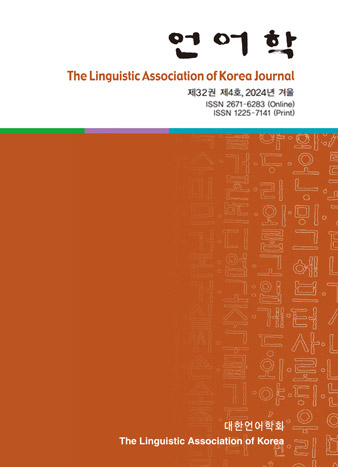대한언어학회 전자저널
32권 4호 (2024년 12월)
- On Multiple Cleft Constructions in Korean
-
Jong Un Park
Pages : 67-96
Abstract
Park, Jong Un. (2024). On multiple cleft constructions in Korean. The Linguistic Association of Korea Journal, 32(4), 67-96. Multiple cleft constructions, where there are more than one focus elements in the pivot position, have received little attention in the generative literature on Korean, as opposed to Japanese. Only a few researchers (e.g., Cho et al., 2008; D. Chung, 2021) have explicitly acknowledged the availability of multiple clefts in Korean. This paper first argues that multiple clefts are allowed in Korean, albeit restrictively, and demonstrates that they can be licensed when being congruent to the most prominent Question under Discussion (QUD) in the discourse context. Then, we suggest that in the course of derivation in syntax, multiple pivots form a single constituent via Oblique Merge (OM), suggested by D. Chung, but it is further argued that there are two routes in which multiple foci are introduced into the derivation, depending on whether they are selected arguments or unselected adjuncts (cf. J.-I. Yeom, 2014; H.-K. Wee, 2015, 2016). As an extension, we propose that the application of OM is constrained by the Phase Impenerability Condition and Transfer (Chomsky 2000, 2001), which make it possible to derive the so-called Clausemate Condition for multiple foci in the construction.
Keywords
# single cleft # multiple clefts # QUD # oblique merge # phase impenetrability condition # transfer # clausemate condition
References
- Cho, S., Whitman, J., & Yanagida, Y. (2008). Clefts in Japanese and Korean. Proceedings from the Annual Meeting of the Chicago Linguistic Society, 44(1), 61-77.
- Chomsky, N. (2000). Minimalist inquiries: The framework. In Roger Martin, David Michaels & Juan Uriagereka (Eds.), Step by step: Essays on minimalist syntax in honor of Howard Lasnik (pp. 89–155). Cambridge, MA: MIT Press.
- Chomsky, N. (2001). Derivation by phase. In Michael Kenstowicz (Ed.), Ken Hale: A life in language (pp. 1–52). Cambridge, MA: MIT Press.
- Chomsky, N. (2013). Problems of projection. Lingua, 130, 33-49.
- Chung, D. (2021). Multiple focus constructions in Korean and Oblique Agree/Merge. [written in Korean] Seoul: Hankwuk Publishing.
- Declerck, R. (1988). Studies in copular sentences, clefts, and pseudo-clefts. Dordrecht: Foris.
- Hiraiwa, K., & Ishihara, S. (2002). Missing links: Cleft, sluicing, and “no da” construction in Japanese. In T. Ionin, H. Ko & A. Nevins (eds.), Proceedings of the 2nd HUMIT sttudent conference in language research, (MIT working papers in linguistics 43) (pp. 35-54). Cambridge, MA: MITWPL.
- Hiraiwa, K., & Ishihara, S. (2012). Syntactic metamorphosis: Clefts, sluicing, and in-situ focus in Japanese. Syntax, 15(2), 142-180.
- Hoji, H. (1987). Japanese clefts and chain binding/reconstruction effects. Paper presented at the Sixth West Coast Conference on Formal Linguistics, University of Arizona, 20-22 March.
- Hoji, H.. & Ueyama, A. (2003). Resumption in Japanese: A preliminary study. Handout from WECOL 2003. University of Arizona, Tuscon.
- Ishii, T., & Abgayani, B. (2019). On multiple cleft constructions in Japanese. Paper presented at Chicago Linguistic Society 55. Chicago, IL.
- Kang, B. (2006). Some pecularities of Korean kes cleft constructions. Studia Linguistica, 6(3), 251-281.
- Kim, J.-B. (2015). Copular constructions and asymmetries in the specificational pseudocleft constructions in Korean. Language and Linguistics, 17(1), 89-112.
- Kim, J.-B., & Sells, P. (2007). Some remarks on Korean nominalizer kes and information structure. Studies in Generative Grammar, 17(4), 470-494.
- Kim, J.-y., & Lee, C. (2008). Why multiple clefts are disallowed. In Charles B. Chang & Hannah J. Haynie (Eds.), Proceedings of the 26th West Coast Conference on Formal Linguistics (pp. 332-339). Somerville, MA: Cascadilla Proceedings Project.
- Kim, S.-W. (2020). Syntax of specificity and predication with special reference to ‘kes’-cleft constructions. [written in Korean] In S.-W. Kim, M.-K.
- Park & G.-S. Moon (Eds.), Modern linguistic studies in cleft constructions (pp. 189-214). Seoul: Global Contents.
- Koizumi, M. (2000). String vacuous overt verb raising. Journal of East Asian Linguistics, 9(3), 227-285.
- Miyamoto, Y. (2024). Covert conjunction in Japanese multiple clefts. Paper presented at SICOGG 26 & WAFL 18 joint conference. Jeonju, Korea.
- Park, D.-W. (2021). Korean specificational pseudoclefts as caseless focus nominal extraction. Studia Linguistica, 75(3), 538-574.
- Park, J.-U. (2023). QUD, focus, and adjunct ellipsis. The Linguistic Association of Korea Journal, 31(4), 153-179.
- Park, M.-K. (2014). On the syntax of multiple fragments in Korean. Studies in Modern Grammar, 79, 1-22.
- Park, M.-K., & Shin, U.-J. (2014). On the syntax of multiple fragments in Korean. Studies in Modern Grammar, 80, 1-22.
- Park, S.-Y. (2014). The syntactic structure of Korean cleft constructions and a theory of ellipsis. [written in Korean] Eneohak, 68, 35-57.
- Roberts, C. (2012). Information structure in discourse: Towards an integrated formal theory of pragmatics. Semantics and Pragmatics, 5(6), 1-69. Published version of draft circulated in 1996 and amended in 1998.
- Saito, M. (1994). Additional-wh effects and the adjunction site theory. Journal of East Asian Linguistics, 3, 195-240.
- Sohn, K.-W. (1994). Adjunction to argument, free ride and a Minimalist Program. In M. Koizumi & H. Ura (Eds.), Formal Approaches to Japanese Linguistics 1 (pp. 315-334). Department of Linguistics & Philosophy, MIT: Cambridge, MA.
- Sohn, K.-W. (2000). Operator movement and cleft conditions. Paper presented at the International Workshop on Generative Grammar. Seoul, Korea.
- Takano, Y. (2002). Surprising constituents. Journal of East Asian Linguistics, 11, 243-301.
- Takano, Y. (2015). Surprising constituents as unlabeled syntactic objects. Nanzan Linguistics, 10, 55–73. Nagoya: Nanzan University, Center for Linguistics.
- Takano, Y. (2020). Exploring Merge: A new form of sideward movement. The Linguistic Review, 37(1), 7-45.
- Wee, H.-K. (2015). The meaning of kes-clefts and optionality of postpositions. [written in Korean] Language Research, 51(3), 771-792.
- Wee, H.-K. (2016). A Meta-linguistic Interpretation of the subject of kes-cleft construction. [written in Korean] Language and Information, 20(1), 111-125.
- Yeom, J.-I. (2014). So-called cleft constructions in Korean and some meanings of “kes”. [written in Korean] Language and Information, 18(2), 103-122.
